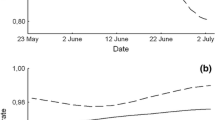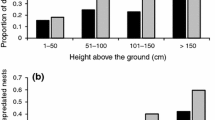Summary
Pairs of fieldfares breed singly or in colonies. Their breeding season was subdivided into an early part, when the trees were still leafless, and a late part, when the trees had leaves. Early colonial pairs has a significantly higher nesting success than single pairs. However, amongst late broods the nesting success of both categories of pairs was the same. Colonies of only two pairs show a weak trend suggesting that it could be advantageous for early broods to have a neighbour nearby, while the nesting success of late broods seems to be highest if the neighbour is farther away. The number of neighbours is more important than the distance to the nearest neighbour when colonies of different sizes are examined. The nesting success of colonial broods is also influenced by the time of breeding. Success increases with colony size, in early colonies, but the opposite applies for the late breeding season.
A little owl was placed near single and colonial nests to show how communal defence contributed to the greater success of early colonial nests. Predators entering a colony risk being contaminated by significantly more faeces due to the higher rate of attacks by fieldfares using aimed defecation near colonial nests and these could affect the predators' flying ability.
The possibility of fieldfare colonies serving as information centres for food finding is also discussed.
Similar content being viewed by others
References
Andersson M, Wiklund CG (1978) Clumping versus spacing out: experiments on nest predation in fieldfares (Turdus pilaris). Anim Behav 26:1207–1212
Bezzel E (1975) Die Wirksamkeit der Kotattacken von Wacholderdrosseln (Turdus pilaris) auf Greifvögel. J Ornithol 116:488–489
Crook JH (1964) The evolution of social organization and visual communication in the weaver birds (Ploceidae). Behaviour (Suppl) 10:1–178
Furrer RK (1975) Häufigkeit und Wirksamkeit des Angriffsverhaltens bei der Wacholderdrossel Turdus pilaris. Ornithol Beob 72:1–8
Furrer RK (1977) Warum brüten Wacholderdrosseln in Kolonien? J Ornithol 118:227–228
Furrer RK (1979) Zum Angriffsverhalten der Wacholderdrossel (Turdus pilaris) und dem Verhalten der Angegriffenen. Ornithol Mitt 31:141–145
Haas V (1980) Ethologische und ökologische Untersuchungen an süddeutschen Wacholderdrosseln (Turdus pilaris L.) unter besonderer Berücksichtigung des Koloniebrütens. Dissertation Fakultät für Biologie, Universität Tübingen
Haas V (1982) Beitrag zur Biologie und Ökologie der Wacholderdrossel (Turdus pilaris L.). Ökol Vögel 4:17–58
Hogstad O (1983) Is nest predation really selecting for colonial breeding among fieldfares Turdus pilaris? Ibis 125:366–369
Horn HS (1968) The adaptive significance of colonial nesting in the brewer's blackbird (Euphagus cyanocephalus). Ecology 49:682–694
Kollmannsperger F (1955) Über Rhythmen bei Lumbriciden. Decheniana 108:81–92
Lack D (1968) Ecological adaptations for breeding in birds. Methuen, London
Löhrl H (1983) Zur Feindabwehr der Wacholderdrossel (Turdus pilaris). J Ornithol 124:271–279
Lübcke W (1975a) Zur Ökologie und Brutbiologie der Wacholderdrossel (Turdus pilaris L.). J Ornithol 116:281–296
Lübcke W (1975b) Nahrungsuntersuchungen an der Wacholderdrossel (Turdus pilaris). Vogelkundl Hefte Waldeck-Frankenberg/Fritzlar-Homberg 1:82–87
Mester H (1976) Defensive Defäkation in der Vogelwelt. Ornithol Beob 73:99–108
Otto C (1979) Environmental factors affecting egg weight within and between colonies of fieldfare Turdus pilaris. Ornis Scand 10:111–116
Slagsvold T (1980) Egg predation in woodland in relation to the presence and density of breeding fieldfares Turdus pilaris. Ornis Scand 11:92–98
Sokal RR, Rohlf FJ (1981) Biometry Freeman, San Francisco, Calif
Tinbergen N, Impekoven M, Franck D (1967) An experiment on spacing-out as a defense against predation. Behaviour 28:307–321
Ward P, Zahavi A (1973) The importance of certain assemblages of birds as “Information-Centres” for food-finding. Ibis 115:517–534
Wiklund CG (1982) Fieldfare (Turdus pilaris) breeding success in relation to colony size, nest position and association with merlins (Falco columbarius). Behav Ecol Sociobiol 11:165–172
Wiklund CG (1983) Social organization and breeding biology of the fieldfare, Turdus pilaris. PhD thesis, University of Göteborg
Wiklund CG, Andersson M (1980) Nest predation selects for colonial breeding among fieldares Turdus pilaris. Ibis 122:363–366
Wiklund CG, Andersson M (1983) Nest defence by solitary and colonial fieldfares Turdus pilaris. In: Wiklund CG PhD thesis, University of Göteborg
Wilcke DE (1962) Untersuchungen über die Einwirkungen von Stallmist und Mineraldüngung auf den Besatz und die Leistung der Regenwürmer im Ackerboden. Monogr Angew Entomol; Beitr Z Angew Entomol 18:121–167
Author information
Authors and Affiliations
Rights and permissions
About this article
Cite this article
Haas, V. Colonial and single breeding in fieldfares, Turdus pilaris L.: a comparison of nesting success in early and late broods. Behav Ecol Sociobiol 16, 119–124 (1985). https://doi.org/10.1007/BF00295145
Received:
Accepted:
Issue Date:
DOI: https://doi.org/10.1007/BF00295145




